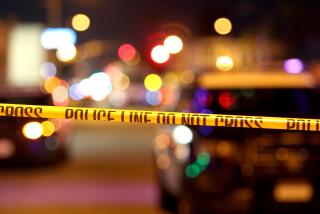Compton Stung by Steep Rise in Killings
Compton has recorded 44 slayings this year -- more than in all of last year -- putting the city of 96,000 on a pace to far surpass homicide rates in the nation’s most dangerous big cities.
If the trend continues, Compton could post as many homicides as it did in the early 1990s, when the city averaged nearly 80 killings a year, figures that made headlines amid a record upturn in crime nationwide.
The new outburst of violence -- much of it tied to gangs -- has alarmed law enforcement officials because it comes after years of declining homicides in the city. Even as the killings in Compton have nearly doubled since last year, nearby areas that also struggle with gang activity, including southeast Los Angeles and Long Beach, have seen homicide rates decline or remain steady.
Until recent months, Compton leaders had used a double-digit decline in violent crime to highlight a turnaround in their long-troubled city. Made synonymous with gangsta rap and ghetto life by N.W.A’s landmark 1988 album “Straight Outta Compton,” the city -- bolstered by its decrease in crime -- pursued another image: “to be a viable, affluent, self-reliant and safe community.”
Local leaders are hard-pressed to explain how things could change so quickly. And officials in nearby jurisdictions are nervously eyeing the turn for the worse.
The increase in killings accounts for much of the 11% upturn in homicides in areas patrolled by the Los Angeles County Sheriff’s Department, which has served Compton since the city’s cash-strapped Police Department was disbanded five years ago. (By contrast, in 2005 the Los Angeles Police Department has recorded a 10% decline in homicides citywide.)
Last year, New Orleans had the highest per capita homicide rate of cities with 100,000 residents or more, with 56.3 homicides per 100,000 residents. At the current pace, Compton’s per capita homicide rate this year would be more than 80.
After renewing the sheriff’s contract late last year amid community praise for the level of service and declining crime, some city leaders now wonder if having their own police force would make a difference. They also question why deputies have arrested suspects or issued warrants in only nine homicides this year.
“They don’t have enough deputies who grew up in the city,” said Mayor Eric J. Perrodin, who was a gang officer for the former Compton police force.
“If you’re not solving the crime, the killer remains on the street,” he added.
Though homicide and gang suppression units are deployed at the discretion of sheriff’s headquarters, patrol officers are assigned to cities based on individual contracts.
Sheriff’s officials agree that they could use more resources but note that their hands are partly tied by how much the city spends. Compton pays about $13 million a year; that’s enough to pay about 75 deputies to patrol the city of 10 square miles.
In contrast, the LAPD’s nearby Southeast patrol station -- which serves about 150,000 residents living in the Nickerson Gardens public housing project and in other neighborhoods, including Watts -- has 258 officers to patrol an area the size of Compton. That station has had 33 homicides this year, down from 44 for the same period a year ago.
On the street in Compton, deputies say, they face a city with a long history of gang activity, gun possession and poverty that combine to make getting to the roots of violent crime difficult.
To make matters more difficult, they have identified no one particular gang conflict or hot spot behind the rise in violent crime. Focusing personnel in one troubled area “doesn’t eliminate the rest of the shootings in the city. The shootings remain constant,” said Det. April Tardy.
Added Capt. Mike Ford, who heads the Sheriff’s Department’s gang suppression unit: “You’ve got to say, ‘What’s going on here?’ ”
With no easy explanation of why crime declined for more than a decade, experts worry that a reversal could be quick. Is the doubling of homicides in Compton an anomaly or a sign of things to come?
As the killings have mounted -- with little attention paid outside the community and scant new resources made available -- the frustration of some longtime deputies has also risen.
“If Beverly Hills or Santa Monica had these many shootings, the politicians and law enforcement would find the courage to put a stop to these shootings,” said Lt. Bob Rifkin, who runs operations for Ford’s unit. “There is so much apathy in South-Central and in Compton that it’s sickening. I see it in the media, in politicians, in law enforcement, in the courts, in the juries.”
*
Shortly after 11:30 p.m. on June 11, a Saturday, a man armed with a shotgun opened fire on partygoers at a tiny lemon-colored Compton home, wounding a man and four women.
One of the women was eight months pregnant. The gunfire killed her unborn child.
For Alex Leon, a pastor at Victory Outreach church in Compton who has long worked with local gang members, the attack was enough to make him ask how it had gotten so bad.
“She got shot and her baby died, and to me, that needs to stop, because look at this: a kid that wasn’t even born, already dead, by violence?” said Leon, shaken enough by the recent shootings -- which have killed 10 teenagers -- to decide to attend only church parties where he knows all the guests well.
In the weeks since then, 11 more people have been killed in Compton; 10 were shot, one was stabbed. Three died last week: The most recent was the shooting death Friday evening of a man sitting in a car parked near a middle school. In some areas of Compton, killings are clustered, with multiple deaths on the same street, often weeks or even months apart.
Deputies have had little success in solving cases. In more than half of the homicide investigations, they say, the suspect is unknown. In most of the rest, they have only a vague description that includes race and gender.
Also troubling is an even steeper rise in gang-related shootings in Compton and adjacent unincorporated areas -- with 111 recorded by the end of April, compared with 54 for the same period a year ago. By the end of June, Compton deputies had reported 147 assaults with firearms compared with 107 for the first six months of 2004.
For state Atty. Gen. Bill Lockyer, who called a meeting this month in Pasadena to talk to local law enforcement officials, academics and gang intervention workers about crime, the problems in Compton reflect a larger truth about gangs in California.
“If you look past the short-term numbers and trends, what you do see is a long-term increase in gang activity,” Lockyer said. “Is there a worry it spreads? Yes.”
Lockyer noted a recent Rand Corp. study done for his department that found that about half the homicides in Los Angeles County were believed to have been tied to gang activity; 25 years ago the portion was about 14%.
In Compton, many homicides and shootings have the hallmarks of gang crime, deputies said. But gang suppression deputies have not traced shootings to specific long-term disagreements among Compton’s numerous active gangs, making the violence harder to predict or target.
“It’s not just two gangs fighting each other or four gangs fighting each other; it’s twentysomething gangs. It’s sporadic,” said Rifkin, who worked out of Compton until earlier this year, when he became head of operations countywide for the sheriff’s gang unit.
By contrast, at the Sheriff’s Department’s nearby Century station, which covers the city of Lynwood and such unincorporated areas as Willowbrook, Florence and Firestone, officials have identified a gang war believed largely responsible for an increase in homicides and shootings there. A task force has been formed to try to stem the violence, which deputies have traced to a conflict between one black gang and one Latino gang.
In Compton, community leaders say they need help.
“These gangs are your local community terrorists,” said Royce Esters, a Compton resident and president of the civil rights group National Assn. for Equal Justice in America. “When they had the Ku Klux Klan, they brought the federal government in.”
Esters said he sees deputies patrolling in their cars but rarely getting out to talk to residents. Like others who have watched with alarm as more and more people have been killed this year, he said his area needs more homicide detectives.
Sheriff’s officials agree that more deputies are needed.
“If you put a one-person car out in the middle of Compton and he’s chasing the radio all day, there is no time for proactive law enforcement,” Rifkin said. “Everybody is overloaded.”
Perrodin, the mayor, said he hoped that city revenues would rise, making it possible to put more deputies on the street. But he also plans to ask for help from Washington in the form of assistance from agencies that include the FBI, the Bureau of Alcohol, Tobacco, Firearms and Explosives, and the Drug Enforcement Administration.
Capt. Eric Hamilton, who heads the Compton sheriff’s station, said his deputies had helped to bring crime down significantly over the four previous years.
“I don’t want people to believe that we have failed as an organization,” Hamilton said. Still, he added, law enforcement in the city has been hindered by the low level of staffing.
“We need more resources; we’ve asked for more resources,” Hamilton said. He said appeals to Compton’s City Council have resulted in funding for two more patrol deputies, but he added that far more are needed.
Experts on gang activity said Compton’s crisis underscores the cycles of gang violence and how hard it is to predict levels of crime.
“We don’t do anything to cause a gang to go away,” said Wes McBride, president of the California Gang Investigators Assn. and a retired sheriff’s gang suppression officer. “They just go quiet for a while.”
McBride said the concentration of gangs in and around Compton -- an area he said “probably has as many gangs as any place in the world” -- makes it a spot to watch for trends. As more people are shot or killed, McBride said, the likelihood increases that the victim has relatives and friends in other areas willing to pick up the fight.
For Velera Dudley, who has lived just east of the Compton Airport for 34 years, the signs of rising crime became obvious in December, when she started noticing more makeshift memorials on the streets where she walks. Now, Dudley said, she and her neighbors don’t go out to water their lawns after dark, fearing drive-by shootings.
“We’re sick of it,” Dudley said.
Willie B. Chatmon, a great-grandmother who lives two blocks from an area hit in the spring with six killings in six weeks, said her children and grandchildren have repeatedly asked her to move.
Although she worries, Chatmon so far has refused to leave her longtime home.
The killings are “increasing more and more. I don’t know the reason, but I just want it to stop,” Chatmon said as she watered her manicured lawn in the twilight on a recent warm summer evening.
“It’s strange; they never find out who kills some of these people.”
More to Read
Sign up for Essential California
The most important California stories and recommendations in your inbox every morning.
You may occasionally receive promotional content from the Los Angeles Times.












